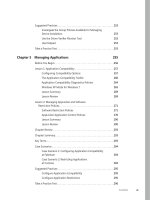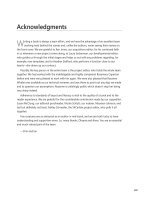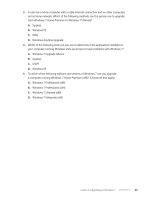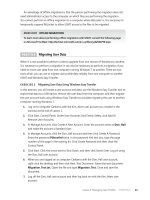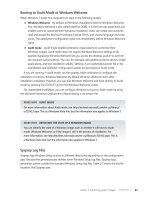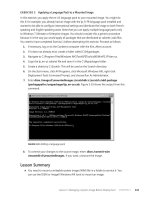Configuring Windows 7 (Training Kit) - Part 8 doc
Bạn đang xem bản rút gọn của tài liệu. Xem và tải ngay bản đầy đủ của tài liệu tại đây (166.47 KB, 10 trang )
Lesson 3: Managing User Profiles CHAPTER 1 43
An advantage of offline migrations is that the person performing the migration does not
need administrator access to the computer on which they are performing the migration.
You cannot perform an offline migration on a computer where BitLocker is. It is necessary to
temporarily suspend BitLocker to allow USMT access to the files to be migrated.
More Info OFFLINE MIGRATIONS
To learn more about performing offline migrations with USMT, consult the following page
on Microsoft TechNet: />Practice Migrating User Data
When it is not possible to perform a direct upgrade from one version of Windows to another,
it is necessary to perform a migration. It can also be necessary to perform a migration if you
need to move user data from one computer running Windows 7 to another. There are two
tools which you can use to migrate user profile data reliably from one computer to another:
USMT and Windows Easy Transfer.
exercise 1 Migrating User Data Using Windows Easy Transfer
In this exercise, you will create a user account and data; use the Windows Easy Transfer tool to
export that data to a USB device; remove the user data from the computer; and then migrate
the user account back using Windows Easy Transfer to simulate migrating the user to another
computer running Windows 7.
1. Log on to computer Canberra with the Kim_Akers user account you created in the
exercise at the end of Lesson 1.
2. Click Start, Control Panel. Under User Accounts And Family Safety, click Add Or
Remove User Accounts.
3. In Manage Accounts, click Create A New Account. Enter the account name as Don_Hall
and make the account a Standard User.
4. In Manage Accounts, click the Don_Hall account and then click Create A Password.
Enter the password P@ssw0rd twice. In the password hint text box, type the page
number of this page in the training kit. Click Create Password and then close the
Control Panel.
5. Click Start. Click the arrow next to Shut Down, and then click Switch User. Log on using
the Don_Hall user account.
6. When you are logged on to computer Canberra with the Don_Hall user account,
right-click the desktop and then click New, Text Document. Name the text document
Migration_Test.txt. Open the file and type Migration_Test. Close and save the
document.
7. Log off the Don_Hall user account and then log back on with the Kim_Akers user
account.
44 CHAPTER 1 Install, Migrate, or Upgrade to Windows 7
8. Connect the USB storage device that you will use to store Windows Easy Transfer data
to the computer.
9. Click Start. In the Search Programs and Files text box, type Windows Easy Transfer
and then press Enter.
10. On the Welcome To Windows Easy Transfer page, click Next. On the What Do You
Want To Use To Transfer Items To Your New Computer? page, click An External Hard
Disk Or USB Flash Drive.
11. On the Which Computer Are You Using Now? page, click This Is My Old Computer.
12. Windows Easy Transfer then performs a check of what information can be transferred.
On the Choose What To Transfer From This Computer page, ensure that only the
Don_Hall user account is selected as shown in Figure 1-22. You do not need to migrate
Kim_Akers or Shared Items in this exercise. Click Next.
FIGURE 1-22 Select items for migration.
13. On the Save Your Files And Settings For Transfer page, enter the password P@ssw0rd
twice and then click Save.
14. In the Save Your Easy Transfer file dialog box, specify the USB storage device that you
connected to the computer in step 8 and then click Save. When the data has been
saved to the USB storage device, click Next twice and then click Close.
15. Click Start, right-click the Computer item, and then choose Properties. Click Advanced
System Settings. In the System Properties dialog box, click the Settings button in the
User Profiles area to bring up the User Profiles dialog box shown in Figure 1-23.
Lesson 3: Managing User Profiles CHAPTER 1 45
FIGURE 1-23 The user profile list
16. Click on the Canberra\Don_Hall profile and then click Delete. When prompted to
confirm the deletion of the profile, click Yes. Click OK twice to close the User Profiles
and System Properties dialog boxes.
17. Click Start, Control Panel. Under User Accounts And Family Safety, click Add Or
Remove User Accounts.
18. Select the Don_Hall user account and then click Delete The Account. On the Do You
Want To Keep Don_Hall’s Files? page, click Delete Files. Click Delete Account and close
the Control Panel.
19. Log out and verify that it is not possible to log on to the computer Canberra with the
Don_Hall user account.
20. Log on using the Kim_Akers user account.
21. Click Start. In the Search Programs and Files text box, type Windows Easy Transfer
and then press Enter. On the Windows Easy Transfer Welcome page, click Next.
22. On the What Do You Want To Use To Transfer Items To Your New Computer? page,
click An External Hard Disk Or USB Flash Drive.
23. On the Which Computer Are You Using Now? page, click This Is My New Computer.
24. On the Has Windows Easy Transfer Already Saved Your Files To An External Hard Disk
Or USB Flash Drive? page, click Yes, Open The File.
25. Navigate to the location on the USB storage device where you saved the Windows Easy
Transfer migration data in step 14, select the file named Windows Easy Transfer – Items
From Old Computer and then click Open. Enter the password P@ssw0rd.
46 CHAPTER 1 Install, Migrate, or Upgrade to Windows 7
26. On the Choose What To Transfer To This Computer page, ensure that only the Don_
Hall user account is selected and then click Transfer. Click Close to dismiss the Windows
Easy Transfer Wizard.
27. Log off and then log on with the Don_Hall user account. It will be necessary to enter a
new password for the account. Use the password P@ssword. When you log on, verify
that the file named Migration_Test.txt is present on the desktop.
Lesson Summary
n
Windows Easy Transfer can be used to migrate user profile data from computers
running Windows XP, Windows Vista, and Windows 7 to computers running Windows 7.
n
Windows Easy Transfer can migrate data using a Windows Easy Transfer cable or
directly from source computer to destination computer over the network, or it can
store migration data on a removable USB storage device or a network share.
n
USMT 4.0, which is available through the WAIK, is used when it is necessary to migrate
profile data on a large number of computers. USMT can be used to perform an offline
migration.
n
ScanState is run on the source computer. LoadState is run on the destination computer.
n
USMT uses XML configuration files such as MigApp.xml, MigUser.xml, MigDocs.xml,
and Config.xml to control which data is migrated from the source computer to the
destination computer.
n
An offline migration can be performed by booting into Windows PE and running
ScanState.
Lesson Review
You can use the following questions to test your knowledge of the information in Lesson 3,
“Managing User Profiles.” The questions are also available on the companion DVD if you
prefer to review them in electronic form.
note ANSWERS
Answers to these questions and explanations of why each answer choice is correct or
incorrect are located in the “Answers” section at the end of the book.
1. Which of the following operating systems support an offline migration using USMT?
a. Windows 2000 Professional
B. Windows XP Professional
c. Windows Vista
D. Windows 7
Lesson 3: Managing User Profiles CHAPTER 1 47
2. Which of the following utilities can you use to transfer user encryption certificates from
a computer running Windows XP Professional to Windows 7 Professional? (Choose all
that apply.)
a. File Settings and Transfer Wizard
B. USMT
c. Windows Easy Transfer
D. Robocopy.exe
3. Which XML file is used with ScanState to specify information about user profile data
that should be migrated?
a. MigDocs.xml
B. MigUser.xml
c. MigApp.xml
D. Config.xml
4. Which of the following must you download from Microsoft’s Web site to obtain
USMT 4.0?
a. Windows Anytime Upgrade
B. Windows Upgrade Advisor
c. WAIK
D. Microsoft Application Compatibility Toolkit
5. Which of the following types of USMT migration store types minimizes hard disk space
used when performing a wipe-and-load migration?
a. Uncompressed
B. Compressed
c. Hard-link
48 CHAPTER 1 Install, Migrate, or Upgrade to Windows 7
Chapter Review
To further practice and reinforce the skills you learned in this chapter, you can perform the
following tasks:
n
Review the chapter summary.
n
Review the list of key terms introduced in this chapter.
n
Complete the case scenarios. These scenarios set up real-world situations involving the
topics of this chapter and ask you to create a solution.
n
Complete the suggested practices.
n
Take a practice test.
Chapter Summary
n
Windows 7 requires a 1 GHz x86 or x64 processor, 512 MB of RAM for the Starter or
Home Basic editions, and 1 GB of RAM for other editions. To support the Aero UI,
Windows 7 requires a graphics card with 128 MB RAM.
n
Windows 7 can be dual-booted with Windows XP and Windows Vista. A computer
requires multiple partitions to support dual-boot.
n
Windows 7 can be installed from DVD-ROM, USB storage device, network share, or WDS.
n
The Upgrade Advisor can inform you of which hardware and software attached to your
computer running Windows Vista is compatible with Windows 7.
n
You can only upgrade from an x86 version of Windows Vista to an x86 version of
Windows 7. You can only upgrade from an x64 version of Windows 7.
n
You cannot upgrade directly from Windows XP to Windows 7. You can only upgrade
from Windows Vista to Windows 7.
n
Windows Easy Transfer allows migration of user profile data from computers running
Windows XP and Windows Vista to computers running Windows 7. It is suitable for
when a small number of computers need to be migrated.
n
USMT is a command-line tool that allows migrating of user profile data from
computers running Windows XP and Windows Vista to computers running Windows 7.
It is suitable when a large number of computers need to be migrated.
Key Terms
Do you know what these key terms mean? You can check your answers by looking up the
terms in the glossary at the end of the book.
n
dual-boot
n
Netbook
Case Scenarios CHAPTER 1 49
n
side-by-side migration
n
wipe-and-load migration
Case Scenarios
In the following case scenarios, you will apply what you’ve learned about the topics covered
in this chapter. You can find answers to these questions in the “Answers” section at the end of
this book.
Case Scenario 1: Installing Windows 7 at Contoso
You work for Contoso, Ltd. The company has a head office and two branch office locations.
The company has just purchased 50 small form factor laptops on which you want to deploy
Windows 7. A total of 40 of these computers will be deployed at the head office site, with
5 deployed to each of the branch office sites. The small computers do not include DVD-ROM
drives, but they do have PXE-compliant network adapters and USB ports. You have tested the
default version of Windows PE available with the WAIK and found that it is not compatible
with the network adapters on these computers. Contoso, Ltd has a volume license agreement
with Microsoft. All servers at Contoso, Ltd have the Windows Server 2008 operating system
installed. You would like to ensure that the computers’ hard disks are protected with
encryption so that data is protected in case they are lost. Considering these facts, answer the
following questions:
1. Which installation media or source could you use to deploy Windows 7 in the head
office?
2. Which installation media or source could you use to deploy Windows 7 in the branch
offices?
3. Which edition of Windows 7 should you deploy to the computers?
Case Scenario 2: Migrating User Data at Fabrikam
You are in charge of supporting client operating systems at Fabrikam. In the head office,
you have 20 users that have computers running Windows 7 Enterprise (x86). You will
be increasing the amount of RAM in these computers from 4 GB to 16 GB and need
to upgrade the operating system to Windows 7 Enterprise (x64). After the upgrade is
complete, users should not be able to boot into the x86 version of Windows 7. You have
10 users at a branch office who currently have computers running Windows XP Professional
that are more than 5 years old. These computers each have only 256 MB of RAM. You do
not have any Windows Easy Transfer cables and do not want to store branch office user
profile data on network drives or on USB storage devices. You will replace these computers
50 CHAPTER 1 Install, Migrate, or Upgrade to Windows 7
with 10 new computers running Windows 7 Professional. Considering these facts, answer
the following questions:
1. What sort of migration should you perform at the branch office, side-by-side or
wipe-and-load?
2. What sort of migration should you perform at the head office, side-by-side or
wipe-and-load?
3. Which technology and method would you use to perform the migrations in the branch
office?
Suggested Practices
To help you master the exam objectives presented in this chapter, complete the following
tasks.
Perform a Clean Installation
As an alternative to performing a clean installation of Windows 7 on a computer that
does not have an existing operating system installed, consider configuring a computer to
dual-boot between an existing operating system and Windows 7.
n
Configure a computer running Windows XP or Windows Vista to dual-boot with
Windows 7. Ensure that you have a separate partition that has more than 15 GB of
space available.
Upgrade to Windows 7 from a Previous Version
of Windows
The Windows 7 Upgrade Advisor is a tool that allows you to determine whether the
applications and hardware on a computer running Windows Vista are compatible with
Windows 7.
n
Download the Windows 7 Upgrade Advisor onto a computer running Windows Vista.
Run the upgrade advisor to determine if any of the hardware or applications used with
the computer running Windows Vista are incompatible with Windows 7.
Migrate User Profiles
The USMT is a fully featured and complex user profile migration tool. Like Windows Easy
Transfer, you can use the USMT to migrate user profiles from computers running Windows XP,
Windows Vista, and Windows 7 to computers running Windows 7.
n
Create a new user account on the computer running Windows 7 named Canberra. Log
in and create an example document.
Take a Practice Test CHAPTER 1 51
Take a Practice Test
The practice tests on this book’s companion DVD offer many options. For example, you
can test yourself on just one exam objective, or you can test yourself on all the 70-680
certification exam content. You can set up the test so that it closely simulates the experience
of taking a certification exam, or you can set it up in study mode so that you can look at the
correct answers and explanations after you answer each question.
More Info PRACTICE TESTS
For details about all the practice test options available, see the section entitled “How to
Use the Practice Tests,” in the Introduction to this book.

